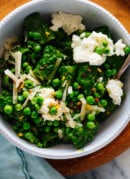Lemony Green Pasta with Peas & Ricotta
- Author:
- Prep Time: 15 minutes
- Cook Time: 15 minutes
- Total Time: 30 minutes
- Yield: 4 servings 1x
- Category: Main
- Method: Stovetop
- Cuisine: Italian
- Diet: Vegetarian
This lemony green pasta recipe tastes as bright as it looks! It’s easy to make with kale, pasta, and peas—they all cook in the same pot. Serve this pasta immediately for the best color and texture; leftovers are best consumed within a day or two. Recipe yields 4 servings.

Ingredients
- Fine sea salt
- 1 large bunch (8 ounces) kale*, preferably Tuscan/lacinato but any variety works
- 1/4 cup extra-virgin olive oil
- 2 large cloves garlic, smashed and peeled
- Zest and juice from 1 medium lemon, preferably organic
- 1/4 teaspoon red pepper flakes, reduce or omit if sensitive to spice
- Freshly ground black pepper, to taste
- 1/2 pound (8 ounces) rigatoni or pappardelle or pasta of choice
- 2 cups (8 ounces) fresh or frozen peas
- 3/4 cup (2 ounces) coarsely grated Parmesan cheese
- 1/2 cup or more ricotta cheese, for garnish
Instructions
- Bring a large pot (5-quart capacity or greater) of heavily salted water to boil. Meanwhile, prepare your kale by slicing or stripping the leaves from the stems (save them). Discard the rough bottom of the stems, then slice the stems into pieces about 1/4-inch wide. Place the stem pieces in a fine-mesh sieve.
- When the water is boiling, place the sieve in the water, resting the lip against the top of the pot. Cook the stems for 3 minutes, then remove the sieve and add all of the kale leaves to the pot. Put the sieve back in the water on top of the leaves and cook for 5 minutes (do not drain the water).
- Meanwhile, warm the olive oil in a small skillet over medium heat. Add the garlic and cook until the garlic begins to sizzle, then reduce the heat to low. Cook gently, lightly shimmying the pan and turning the garlic every now and then, until the garlic is soften and turning lightly golden, about 5 minutes. Remove the skillet from the heat and pour the contents into a stand blender.
- Add the cooked kale stems to the blender when the time’s up. Use tongs to transfer the kale leaves over to the blender (you actually want to bring some of the water with them). Add most of the zest from the lemon, and 1 tablespoon of the juice. Add 1/4 teaspoon salt, the red pepper flakes (if using), plus about 10 twists of freshly ground black pepper.
- Blend until the mixture is completely smooth and silky, adding more spoonfuls of water if necessary to gain traction. Taste, and add more salt, pepper or pepper flakes, and/or another tablespoon of lemon if desired. We want it to taste lemony! Set aside.
- Add the pasta to the boiling water and cook until al dente according to the package directions, stirring often. Place the peas in the sieve and cook them in the water until they’re warmed throughout, about 1 to 2 minutes if fresh, or 2 to 3 minutes if frozen. Set the peas aside.
- Before draining the pasta, scoop out about 1/2 cup of the pasta cooking water with a heat-safe measuring cup. Drain the pasta, then return it to the pot. Pour in the green sauce, about 3/4 of the Parmesan and the peas, and add a small splash of the reserved cooking water (not the end of the world if you forgot it). Stir gently until the pasta is well coated and bright green, adding another splash or two of pasta water to loosen the sauce and make it almost creamy.
- Divide into bowls immediately. Top each with a sprinkle of the remaining Parmesan, a few dollops of ricotta, and a sprinkle of lemon zest and red pepper flakes (both optional). Finish the bowls with a light drizzle of olive oil. Enjoy! Leftovers will keep for up to 2 days in the refrigerator, covered (technically, they’ll last up to 4, but the flavor degrades as time goes on).
Notes
Recipe adapted from Six Seasons by Joshua McFadden with Marcia Holmberg.
*Greens options: I’ve read that you can substitute chard, collard greens, spinach or arugula for the kale. If using spinach or arugula, no need to separate the stems from the leaves—just cook them for 5 minutes like you would the kale leaves. You could also use frozen kale or spinach (8 ounces)—place it in your sieve and run cool water over it until it’s thawed, then rest the sieve in the pasta cooking water until the greens are warmed all the way through.
Change it up: You might enjoy topping your finished pasta with a fried egg, and/or some tender fresh herbs, such as dill, chives or parsley.
Make it dairy free/vegan: Substitute vegan sour cream for the ricotta, and vegan Parmesan for the regular variety (it’s quite salty so just use it as a garnish for the finished dishes).
Make it gluten free: Substitute a sturdy gluten-free pasta, such as a corn and quinoa variety.
▸ Nutrition Information
Recipe from Cookie and Kate: https://cookieandkate.com/lemony-kale-pasta-recipe/
